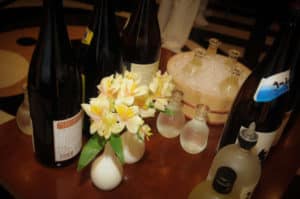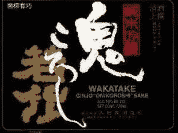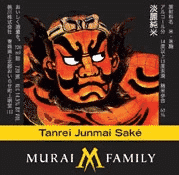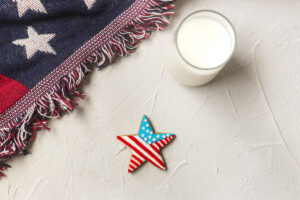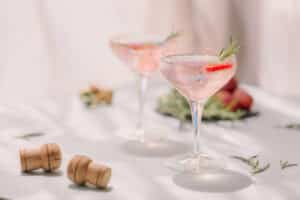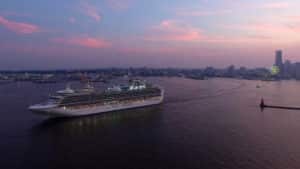 Most people who take cruises featuring wine and cuisine consider destinations like the Caribbean, Alaska, Mediterranean and perhaps the Greek Islands. Surprisingly, a country like Japan is a perfect multi-island destination for a cruise. During a recent Diamond Princess cruise we sailed to all four islands of Japan and Busan, South Korea. Sake and Sushi tastings were the highlight of the cruise adventure.
Most people who take cruises featuring wine and cuisine consider destinations like the Caribbean, Alaska, Mediterranean and perhaps the Greek Islands. Surprisingly, a country like Japan is a perfect multi-island destination for a cruise. During a recent Diamond Princess cruise we sailed to all four islands of Japan and Busan, South Korea. Sake and Sushi tastings were the highlight of the cruise adventure.
This cruise featured a specially prepared Sushi and Sake tasting in the Kai Sushi specialty restaurant onboard the ship, Diamond Princess. The Sushi chef artfully prepared our food pairings. Thai Reznich, Head Waiter and Sommelier, and Takahiro Hirata, Bartender and Sake Certified Specialist, conducted the tasting and described Sake’s styles and aromas.
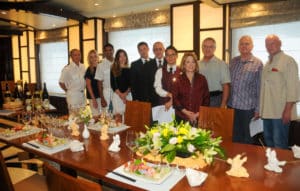 The tasting was an “over-the-top” experience for us and may be offered as a regular feature on future cruises, according to Stephen Reynolds, Food and Beverage Director and Luigi Pascale, Maître d’hôtel. The exquisite tablescape included festive samurai-sculpted napkin figures brandishing bamboo swords in addition to the artfully fashioned sushi platters.
The tasting was an “over-the-top” experience for us and may be offered as a regular feature on future cruises, according to Stephen Reynolds, Food and Beverage Director and Luigi Pascale, Maître d’hôtel. The exquisite tablescape included festive samurai-sculpted napkin figures brandishing bamboo swords in addition to the artfully fashioned sushi platters.
 Sake is considered “rice wine” but actually is not a real wine at all. Sake making has more in common with beer brewing. This alcoholic beverage is made by taking specially milled and polished rice varieties and fermenting them with water and selected yeasts in a parallel fermentation process. This produces a 15-20% alcohol drink. The % of milling and polishing or “Seimai-Buai” of the rice determines the quality and style levels. These styles also dictate whether the sake is served chilled vs. warmed. My personal favorite style was the Junmai-Daiginjo sake, featuring a fragrant, floral, spicy-scented aroma that is served slightly chilled and paired with the shrimp and salmon sushi. Most premium sake’s should be slightly chilled.
Sake is considered “rice wine” but actually is not a real wine at all. Sake making has more in common with beer brewing. This alcoholic beverage is made by taking specially milled and polished rice varieties and fermenting them with water and selected yeasts in a parallel fermentation process. This produces a 15-20% alcohol drink. The % of milling and polishing or “Seimai-Buai” of the rice determines the quality and style levels. These styles also dictate whether the sake is served chilled vs. warmed. My personal favorite style was the Junmai-Daiginjo sake, featuring a fragrant, floral, spicy-scented aroma that is served slightly chilled and paired with the shrimp and salmon sushi. Most premium sake’s should be slightly chilled.
Consider that Sake has a two millennia beverage heritage. Sake is produced in several regions of Japan including Kobe, Kyoto, Hiroshima, and Fukushima. Sake does not carry a vintage year like red and white wines, as the rice harvests tend to be more stable than grape harvests. The purity of the water in the region is important as it accounts for 80% of the content. Hard water produces a more masculine-style sake and soft water a more feminine-style sake. The winter snow-melt in the Japan mountains feeds the spring water source for sake creating ideal cold fermenting conditions.
 Most sake bottles are beautifully labeled and etched, adding to the allure of the beverage. Sake should be stored chilled after opening and consumed within 3 days. Most sake is unaged.
Most sake bottles are beautifully labeled and etched, adding to the allure of the beverage. Sake should be stored chilled after opening and consumed within 3 days. Most sake is unaged.
With destinations like Tokyo, Yokohama, Nagasaki, Mt. Fuji, Kochi, and the north island of Hokkaido, cruisers can get a thorough picture of the culture, traditions, food and beverages of Japan. The Diamond Princess is one of Princess Cruise Lines Asia-destination ships. It was even built in Nagasaki, Japan. The ship passengers and guests were predominantly from Japan, China, the USA, Canada, New Zealand, and Australia. The dual English/Japan language accommodation ensures that the guests receive the most accurate cruise information and cultural attention. Specialty restaurants like the Sterling Steakhouse, Sabatini Italian venue, and the Kai Sushi restaurant are available making culinary exploration possible and Sake and Sushi pairing at-sea a reality.
A Sake Primer
Sake Terms
Seimai-Buai – degree of milling of the rice grain.
Koji – a mold that has enzymes for converting the rice grain’s starch into simple sugars. It adds aromas and flavors
Shu – Sake
Nigori – unfiltered sake
Taru Sake – is cedar tank brewed sake
Nama/Namazake – unpasteurized sake. It should be stored cold.
Koshu – aged Sake
Kijoshu – dessert sake
Genshu – undiluted sake
Principle Categories of Sake
Futsū-shu – typical or ordinary table sake.
Honjōzō – has a Seimai-Buai (degree of milling) of at least 70%, or 30% of the outer portion of each rise grain has been ground away.
Junmai – means the absence of any additional distilled alcohol added. This is a sake is milled 30% with 70% of the grain remaining.
Ginjō – Sake that is made up of rice milled 40% with 60% of the grain remaining.
Daiginjō – must be made with rice, yeast, water, and koji mold with a Seimai-Buai of 50% or more. It often gets milled down to 35%, a labor-intensive effort. It is light, delicate and fragrant. Considered a premium sake
Ginjō – Sake that is made up of rice, water, koji mold, yeast and a potion of added distilled alcohol. The rice is milled 40% with 60% of the grain remaining.
Questions and Answers with Diamond Princess Staff
Question (Tricia Conover, CSS, Diploma of Wine Candidate): What is a perfect pairing with Sake?
Answer (Takahiro Hirata, Bartender and Certified Sake Specialist):
A perfect pairing for sake is most Japanese food especially those with saltiness like roe or caviar.
Question (TC): How many meals are served onboard each day? Tell me about the wine tasting sessions you offer.
Answer (Thai Reznich, Head Waiter and Sommelier):
We serve over 15,000 meals a day for our guests and staff. We also offer two regularly scheduled wine tastings. The Maître D’Hotel Wine Club tasting features reserve wines.
Question (TC): How much food and disposables are consumed each week onboard the Diamond Princess?
Answer (Carmelo Massano, Hotel Inventory Manager):
We use 15 tons of consumables each week that includes food, beverages, paper products, etc. We do a physical inventory each week and take into account the nationality and tastes of the passengers coming onboard each week. That way we can replenishment the stock so the selections perfect for our guest. We are extremely sensitive to the wine and spirits desired and offer a wide range of beverages including premium wines, spirits, and sake.
Question (TC): How many staff do you have onboard to assist the guests and run the ship?
Answer (Luigi Pascale, Maître d’ Hotel): We have over 1000+ crew members to make the cruise pleasurable and comfortable for our guests.
Some Suggested Sake’s
Japan Prestige Sake Wakatake Oniforoshi “Demon Slayer”
5 Stars; $57.99
Tasting notes: This Daiginjo Sake is silky and aromatic. Serve chilled.
5 Stars; $19.99
Tasting Note: This gold medal-winning producer features a crisp and clean sake to match with most sushi dishes.



